

|
Back to |
| The Front Page |
| Letters & Opinion |
|
National Croquet Center and Australia’s Victoria Centre embrace fresh, new strategies |
|
an editorial by Bob Alman pictures courtesy of the National Croquet Center, The Victorian Croquet Center, Bob Alman, and others as credited Posted September 10, 2012
|
This factual report must be labeled an editorial, given the author’s long involvement in the management and operation of the National Croquet Center--as the organizer and manager in its first three years, beginning in 2000, and currently as consultant to the Acting General Manager, lifetime member of the NCC club, volunteer instructor and member of the club’s Membership Committee. My opinions on organizational development, grounded in facts and direct observation, are nevertheless my opinions. Readers are invited to comment in any way by posting to the linked conversation in our online Forum titled “MEGA-CENTRES UPDATE, 2012”
The building of the National Croquet Center in Florida and the Victoria Croquet Centre in a suburb of Melbourne were both products of the vision and determination of two men. As to how and whether these facilities were to generate the cost of their building and maintenance, neither of these men had a clue. In one case--in Florida--the prime mover and shaker at least knew who to hire to get it done, and he had the money and will to back up his vision...until he suffered a stroke before his pet project was completed, delivering the management responsibility of this huge project to the organized chaos of non-profit boards, committees, and other volunteers.
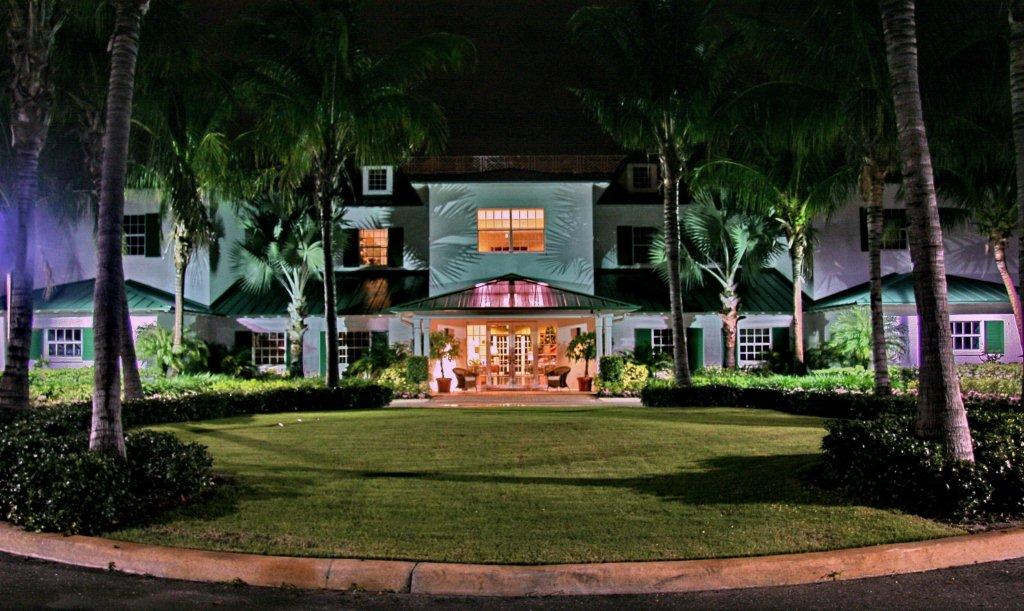
|
| The National Croquet Center's elegant clubhouse is perfect for hosting evening events for groups up to 300 or more in its several intimate first-floor spaces and on its broad wrap-around veranda, even without the ballroom upstairs with room for more than 200. |
In Victoria, the construction money came in overabundance from a real estate windfall that enriched the Victorian Croquet Association beyond all precedent, leading almost inevitably to the construction of a croquet centre which, although smaller and cheaper to build than the one in Florida, had the 12 courts, meeting rooms, and other facilities sufficient to be labeled by a croquet journalist a “mega-centre.”
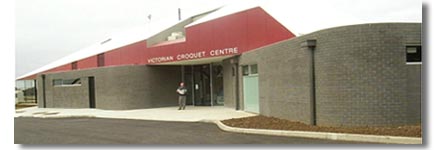
|
| The Victoria Croquet Centre was built as a 12-court headquarters for the Victorian Croquet Association. It opened officially in 2007. George Latham photo. |
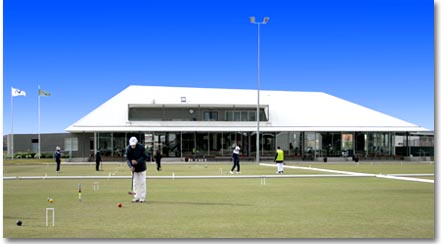
|
| The Victoria Croquet Centre, in a Melbourne suburb, is the biggest croquet facility in the Southern Hemisphere. Here's what it looked like in September, 2012, during the Australian Croquet Association Golf Croquet Interstate Shield competition. Jim Clement, secretary of Croquet Victoria, explains, "It was our winter, with quite a cool wind, hence the dress." |
| BREAKTHROUGH IN MEMBERSHIPS AT THE NATIONAL CROQUET CENTER |
|
After seven years of floundering through several approximately annual successive tenures of failed onsite management, the newly organized members club has re-discovered the organizational benefit of getting new members into the club by any expedient means in the short term. The goal is to build membership to the maximum level of manageability while expanding and improving the social attractions of the Center through the greater numbers that translate to more and better hours for the bar and dining. Amidst the inferno of the Palm Beach summer, the Summer League in its fourth year hit pay dirt. Combining novice players with regular players of the club, the novices were offered a half-price Full Membership in celebration of the Ten-Year Anniversary of the club. The result at latest count: 50 new Full Members at a bargain price of $600 each for the first year—an increase of about 25 percent in local membership at a single go, and a welcome windfall to a cash-strapped organization in its slack season.
At the same time, many influential members of the club and its Membership Committee have agreed, in principle, to support the restoration of the relatively inexpensive ($300) Social membership eliminated at the beginning of 2005, when there were more than 100 members in that category. It’s a practical, easily managed and cost-effective Golf Croquet membership for half-court play at limited times scheduled to feed traffic to the bar and the dining room.
All that is needed now to complete the Center’s “comeback” formula is an infusion of capital to allow the hiring of a competent on-site manager to integrate all the functions of a successful multi-functional business enterprise.
|
Both projects WERE built, and then the essential questions changed, as many continued to speak rather pointlessly of “what should have been done, instead.” If the original projections and expectations were either nonexistent or way off-track, it no longer mattered. Now the question was, in both cases, “How are we going to ensure the success of this facility?”
“Success” is measured differently for the two Centres. In Victoria, success can be realized through the value (not counted in money) that 12-court Centre provides for croquet in Victoria and in Australia generally. In South Florida, the economic reality requires that success be measured by achieving financial sustainability.
The founders of both Centres are, sadly, long dead. They succeeded in getting these breakthrough facilities built. Now their successors have the job of making them successful.
The National Croquet Center would probably not exist today had not David McCoy, first as CFO of the Croquet Foundation of America (owners of the Center) and then as President and CFO, taken on the responsibility in 2009 of saving the world’s largest and arguably the finest showcase of the sport in the world.
McCoy, an experienced corporation man with a long and successful career at Exxon, had years ago undertaken a similar commitment with Manhattan’s York Theatre Company, and is quite properly credited with saving that remarkable, award-winning organization as well, combining organizational and management savvy with direct financial contributions of his own at critical junctures.
He is supported in both enterprises by spouse Millie McCoy, who brings to the table her own professional expertise as an executive head-hunter, confidant, and helpmate—especially in croquet personnel and management matters.
| PERSISTENT RUMORS SAY THE VICTORIA CROQUET CENTRE WILL BECOME THE NATIONAL HQ OF THE AUSTRALIA CROQUET ASSOCIATION. |
|
Although no one will officially confirm it, serious deliberations are under way to make the Victorian Croquet Centre the national headquarters of the Australia Croquet Association as well as the official headquarters of the Victoria Croquet Association. This makes sense from a population and transportation standpoint, and the Centre already is the favored Australian site for the biggest events of the World Croquet Federation as well as the ACA and the Victoria state organization. Among the major sticking points are space: Should the Board Room of the Victorian Centre or the caretaker’s apartment be converted as the ACA administrative headquarters, or should the ACA share office space with the VCA administrator? A more important point, perhaps, is interstate jealousy. The agreement already in force to shift major events around to the various states whenever feasible will likely remain in force.
The Victoria Centre is only five years old, and many of the operational kinks some VCA members complained about most bitterly have been effectively addressed if not entirely resolved. Efforts are being made to re-start a local club and to rent out the function space of the clubhouse more frequently and more lucratively, according to Jim Clement, secretary of the VCA. Given the promise of continued funding from the organization’s considerable investments, a bright future of the Victoria Centre seems assured in the year 2012. The 2012 Annual Report of the Victoria Croquet Association, on the website, shows total equity of nearly $9,000,000—more than $3,000,000 of it in cash—which surely makes the VCA one of the richest croquet organizations in the world.
|
David is highly ranked in croquet and competes regularly in a number of major events, which keeps him in contact with many of the most enthusiastic financial backers of the sport in America.
Shortly after agreeing to join the CFA Board and to personally deal with the pending $120,000 shortfall in the summer of 2008 owing largely to the Great Recession and the loss of all of its major corporate event business and severe drops in all other revenue sources, McCoy was thrown the additional challenge of a $750,000 past-due note and mortgage owed to the estate of the Diane Blow family. He and others organized a USCA-wide fundraising campaign to address the operating loss. To restructure the debt he personally pursued individual donors and formed a Land Trust of croquet-playing investors (secured by a second mortgage) to loan money to the CFA to pay off a major portion of the debt, the balance of which can now be repaid over the long term.
Next he turned his attention to the awkwardly set up organizational structure that no longer supported the mission of the CFA. Working with a not-for-profit lawyer he eliminated a for-profit subsidiary of CFA (called “Croquet Enterprises) that was running the membership club and most of the other operations of the Center.
McCoy formed a new, not-for-profit sports club--The National Croquet Club- – with its own independent board of directors and committees charged with growing the local membership and managing their own interests and concerns. That board negotiated a Facilities Sharing Agreement with the CFA for use of the NCC facilities as its headquarters.
He then moved all other operations of the Center back to the Croquet Foundation of America, as essentially all of these activities directly supported the not-for-profit mission of the CFA to promote and develop the amateur sport of croquet. Donations to the CFA in support of the Center therefore now became tax-deductible, whereas formerly they were not. Many other operational issues were addressed as a result of an internal audit.
Significant improvements to the grounds and the physical plant were made, despite a severely limited budget. McCoy says that many more improvements are in the planning stage, pending donor support-–including night lighting.
A light touch sometimes works wonders

|
| David McCoy, Acting General Manager of the Florida Center, lives with his wife Millie in Summit, New York, on a 450-acre farm where their new croquet court became playable in September. Here they visit the lake at Cooperstown. They winter in Wellington, Florida, about 10 miles west of West Palm Beach. |
But McCoy is the same age as Bob Alman--73. How long will his energy and determination hold out? If he should exit the action by any means, the Center will be instantly plunged into crisis again. He knows that. I know that. But I suspect most croquet players in the US don’t give it a thought.
They assume that because the Center has survived for more than a decade it will continue indefinitely, despite historical annual losses of more than $100,000. They don’t realize that many of the very wealthy supporters in the East Coast croquet elite have passed on to Croquet Heaven; and the survivors are less likely, every year, to continue to support a facility that because of earlier mismanagement has been wrongly labeled a “white elephant.”
The National Croquet Center at a “tipping point”
In our interview for this article, McCoy told me he believes that the organization is at a “tipping point.” He cites the new organizational structure; the increased resources, enthusiasm, and commitment of the National Croquet Club membership; and the numerous new initiatives now underway by the CFA for corporate events, corporate and foundation support, and publicity for the sport as support for his belief.

|
| The Five-to-Nine Club is an after-work, exclusive gathering of younger people mixing croquet, socializing, eating and drinking, helping to build a broader demographic for the sport in South Florida. |
While he admits we are not there yet, he believes the CFA will soon be transitioning from fundraising for essential operations of the Center to fundraising for charitable programs and enhancements of the croquet experience.
With local membership matters being handled by the Club Board, the CFA Board is substantially refocusing the CFA’s mission toward using the Center for croquet activities that support the charitable and educational aspects of its mission, such as promoting the Senior Games, Croquet Special Olympics, Alzheimer’s support (Jiminy Wickets Program), and the CFA’s programs in support of other local charities. McCoy believes these programs will not only support the individual charitable purposes, but will also provide publicity, sponsorship and membership for croquet. “Everyone will win,” he declared.
In typical fashion, McCoy ended our interview by twisting my arm with a request for a this plug: “If croquet players everywhere, especially those with significant resources, would simply make a donation right now that was reasonable for them, given their assets and other charitable commitments (no one needs to sacrifice), we could accomplish so much for the sport and move us to a whole new level. There are sponsorships, naming and gift-in-kind opportunities. Just give me a call 646-342-3221 or email me at mccoy1165@aol.com.”
What can be learned from the operational history of this Center?
Much of the early history of both of these centers has been forgotten, and rightfully so. Why should anyone care? I care, because I was the guy who organized the National Croquet Center and its members club and managed its development for the first three years. And then I watched as many of the promising initiatives I started passed out of existence, either ignored by lax management or deliberately ended by well-meaning but terribly mistaken big-wigs whose errors were recognized much too late, if at all.
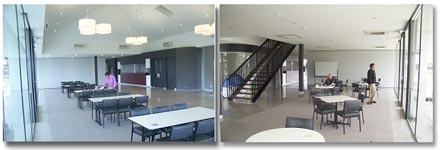
|
| Utilitarian spaces inside the Victorian Centre clubhouse can be used for many purposes. In 2012, rentals to outside groups are increasing but are not expected to entirely close the gap between expenses and income. George Latham photo. |
Later, as editor of Croquet World Online Magazine, I saw the creation of the Victoria Centre, on approximately the same scale as the Florida Center, as just as important a story at the Florida one, and I was determined to report often on the health and development of both.
In Florida, I can accurately record the history of what actually happened, and some of the “why” and “how.” Those mistakes ought to be recognized, as well as the reasons given for making them and the exact financial and organizational consequences of those false steps.
The critical distinction between a local croquet club
and a multi-functional business enterprise
If the mistakes aren't acknowledged, they are likely to be repeated, in the same way that each new generation of local club management repeats its mistakes, over and over again. It’s okay—or at least not all that consequential—when local croquet clubs make mistakes, but multi-functional business enterprises—such as the Victoria Center and the National Croquet Club—must not continue to do that with each new generation of management.
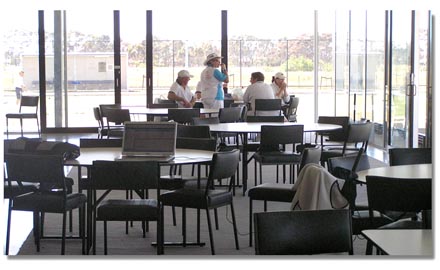
|
| The corner of this room is a favorite spot for viewing many of the courts at once in Victoria. Max Murray photo. |
A short organizational memory is not the only management problem, of course. How do basically good, well-intentioned people turn out to be soooooo wrong? The short answer is "organizational politics." Organizations of all kinds are well known for grinding individual human purposes and will to bits, in favor of the organizational consensus of doubtlessly well-meaning “good guys” who, collectively, are responsible for doing the right thing. Which means, ultimately, that nobody is responsible for anything that happens. Nobody can be blamed.
All a committee needs to do is make a majority decision, and whatever happens thereafter is a function of “the committee.” It’s nobody’s fault, because no single person carried the responsibility.
Now is a good time to reassess
the real potential of the mega-centres
This is an excellent time to review the projections of the past and re-assess the potential of these two centers. Eight or ten or twelve years after the critical decisions were made, many if not most of the movers and shakers then serving have either died or retired. So we don't have to accuse them of any kind of culpability. For those few who are active and still working on their personal agendas: Don’t worry about being exposed here. You know who you are! And it's not too late to mend your ways and correct your thinking!
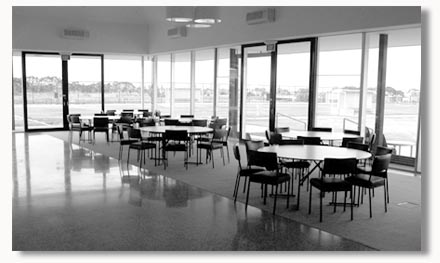
|
| This photo by Adrian Masterman shows the sweeping views available from the room used most often for event dining at the Victorian Centre. |
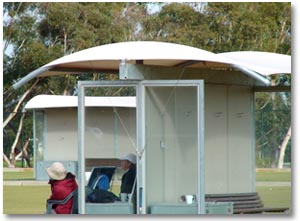
|
| Courtside shelters inadequate to shield players and spectators from wind and rain were among many errors needing correction at the Victoria Centre. These newer shelters are the solution. Photo by Lowen Clarke. |
So nobody still alive needs to be overtly blamed. We can assume they all meant well, despite the inevitable personal agendas. And if mistakes were made, we need to recognize whatever lessons can be learned from those mistakes.
I bill this article an editorial, because although I intend for all the facts to be accurate (and if they're not, I can quickly correct them in this online medium) it is full of my considered opinions. I cannot always be certain of thoroughly distinguishing the facts from my opinion, so the best journalistic practice is to avoid a pretence of a false "objectivity."
Planned and managed development
can be construed as a three-year process
It takes a while to implement a long-term development strategy with competent management, and in the hospitality industry, that time period is about three years. (A local example is the new Hilton on Singer Island, planned to lose money for a full three years before breaking even.)
Although the NCC croquet club had more than a hundred members as early as May of 2001, the original, founding development strategy for the National Croquet Center can be considered to have begun in earnest in May of 2002, when the Clubhouse was open and the entire Center—not just the lawns and the maintenance shed—became fully operable. Although the economy was in a severe post Nine-Eleven depression in both 2002 and 2003, as the organizing manager,
I projected break-even by the end of 2006 or 2007 at the latest--by which point I reasonably projected membership in the club to have reached its optimum level of 600. This projection was based on solidly graphed trends that showed average monthly new-member enrollment of 10 to 15 people, and a net increase each calendar year of at least a hundred members. (As noted earlier, membership reached 375 before the end of 2004, with the original membership categories I set up and managed.)
So what happened? What happened is that after the incapacitation of my boss, Chuck Steuber, long before I left management, a series of amateur, part-time, offsite, volunteer committee members implemented numerous "good ideas" which had the effect of significantly impairing the planned and orderly development of the National Croquet Center.
If any of those people had the slightest conception of what strategic planning actually means in a multi-functional business enterprise--that is, making a rational plan, implementing it, refining it, and managing it over time to achieve a planned objective—there is no evidence of it. So they had one "good idea" after another, while the club's membership numbers floundered and faltered and soon went into reverse.
In Florida, membership was always the priority
We opened the lawns for play on December 7, 2000, soon after I arrived in Palm Beach from San Francisco to work full time on marketing and development. Full memberships were competitive in price with the nearest big club--PGA National--and amenities were considerably greater, with an elegant dining room, the Edwardian bar, and the beautiful clubhouse and veranda overlooking the lawns. It was a croquet club, yes, but a club like no other in the Americas. It was a facility designed to attract members who played croquet but also locals looking for an affordable social club.

|
| The architect had indicated a mushy, broadleaf grass for this "dry rentention area," at the National Croquet Center. When planted, instead, with Bermuda 419, it became "the Harpo Marx lawn," in the words of one corporate client, "the most beautiful lawn in Florida" and perfectly adequate for over-flow half-court play. This lawn, after years of neglect is now being restored for both 9-wicket and Golf Croquet, justifying the NCC's boast as truly "the biggest croquet facility in the world," accommodating 16 or more full-size courts. |
My development strategy, aligned with the caterer I hired, was to attract many new SOCIAL members who had full clubhouse privileges and very limited croquet playing privileges, for Golf Croquet on half courts only. This strategy ensured that the new Social members would bring guests to the dining room, populate the bar, vitalize the social atmosphere, and ultimately enable the Center to expand dining and bar hours and thus improve the quality and market value of club membership for everyone, over time.
The strategy was immediately successful. Lunches on Wednesday and Saturday were always busy, fed by the forty or fifty or more Social members allowed to play half-court croquet from 10 AM to 12 Noon; and for "Twilight Croquet" on Thursday, for which we provided a $13.00 buffet dinner every evening, year-round.
Another initiative brought at least a dozen thirty-somethings into the Social category of club membership through the Five-to-Nine Club started in June of 2003. This promising foray into a broader player demographic offered an attractive environment for after-work social and business networking, including food, drink, and croquet in a beautiful setting, ended abruptly in late July, shortly after I left the Center, when the local committee decided to “combine” it with the regular Thursday social evening.
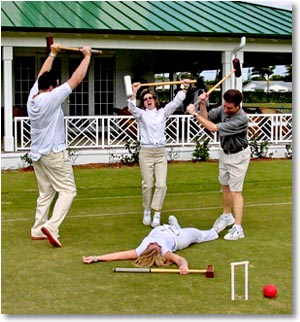
|
| Peer groups like to be left alone to enjoy the sheer fun of croquet. Is there anything more fun than winning? |
With no money in the coffers in July of 2003, I was politely but forcibly “laid off,” and the club survived well enough until 2004, until John Curington, president of the CFA, secured adequate financing for expanding staff and services. The volunteer managers had no yardstick by which to measure my performance in those first three years. So if laying off a mildly eccentric manager from San Francisco was a mistake, it took a while for them to notice the damage actually done by that action.
The first club manager to succeed me started in April of 2004 with a salary and benefits approximately three times what I had asked for. Before the end of the year he decided to do away entirely with the Social membership because club members had told him it was "too cheap." By the beginning of the following year, January 2005, at least 100 half-court limited Social members were gone. They and their friends and guests no longer came to the bar or patronized the dining room. A huge element in the financial viability of bar and dining—the backbone of the social element of any club—was instantly wiped out.
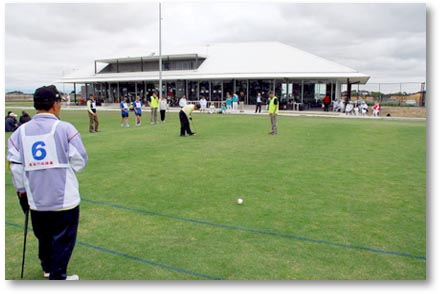
|
| In Victoria, as in South Florida, a big croquet facility can be used for many mallet sports. Here's a Gateball event at the Victorian Croquet Centre. Sue Leitinger photo. |
After that first manager left a year later, having in the opinion of many "raped" the finances of the Center because of a poorly written contract that awarded him bonuses for reducing expenses (but nothing for increasing revenues!)--another manager came in with a club management resume but with no clue about business development.
The new manager could not play croquet and was unwilling to learn. He could not be persuaded (by me and others) to restore the Social membership. I told him, "I'll do all the work as a volunteer; I'll restore Thursday nights as the social anchor of the club." In declining my offer, he said, "People seem to think that you think you know everything." Instead of accepting my offer, he hired a part-time "expert" to re-engineer Thursday evenings. It didn't work. He did not outlast his one-year contract. Good riddance.
The next manager, a croquet player and president of a major club, actually had some sound ideas about development and enthusiasm in abundance, but limited ability to implement. His graphics were excellent (and still valued) and he considered himself “a cheerleader for croquet,” but his numbers did not support his ambition, and he was gone in less than a year.
For all this time, the Croquet Foundation of America and to some extent the Steuber family—-had been making cash available to cover the annual short-falls. It was at this point that a "volunteer manager" appeared—a member of the Croquet Foundation of America board who correctly noted that the salary, expense, benefits, and bonuses of the general managers amounted to close to a hundred thousand dollars alone--which in more prior years had been the largest part of the shortfall, if not the entire amount.
Although he boasted to people that it was the only job he'd ever had, he did some useful things, but he also offended many members and officers as a consequence of conflating “management” with “control.” When his term was over, however, it was clear that the enterprise had still lost close to $100,000 annually during his term.
For most of this time, the general economy and the local hospitality industry had been at full flow, following the disastrous Post Nine-Eleven depression of 2002 and 2003. “Good times” at the Center meant that outside events and parties had generated the largest portion of the revenue—more than half—in each of those years.
The persistent philosophy—if such it can be called—of the Croquet Foundation of America was that EVENTS was to be the financial mainstay of the Center; EVENTS were going to make the Center break even, finally, and membership growth was pretty much to be taken for granted. By 2007, however, it appeared that the business from private parties and special corporate events had maxed out; while memberships, relatively neglected, were at a far lower level than in 2004.
That was the huge false assumption that the current economic crisis now exposes. You can’t count on event sales to carry the Center. Memberships, on the other hand, are relatively recession-proof. People tend to hold onto the club memberships they value.
Is a new business model needed?
The current business model of the National Croquet Center appears to call for selling as many outside events and renting as much court space as possible; and recruiting as many croquet players as possible. In plain words, the Center is run like any local croquet club—NOT like a multi-functional business enterprise; not like an Events Center with a strong Social Club and a world-class Croquet Club. Without a continuous infusion of capital for the many years it will take to recruit "real croquet players" in sufficient quantity to make the critical difference, the Center will fail to break even for perhaps another decade.
But that strategy could not possibly work, even in the long term, because the Center can support no more than 300 resident croquet-playing members, at maximum. (This honors the traditional measure of 25 active, resident member per court.) Currently, the "serious" local croquet players--that is, either the Full Members or "Dual Members" who also belong to other, nearby clubs, bring in a little over $200,000, or slightly more than one third of the Center's annual expenses (not counting a General Manager salary and benefits).
That amounts to about 200 resident members, reflecting the fact that the courts have not reached capacity, even at peak season. A hundred more "real" croquet players could be absorbed on these courts without over-crowding. But how long will it take to generate them? And when you do, how much revenue will you have from membership? (About $350,000, I would guess, based on currently available figures.)
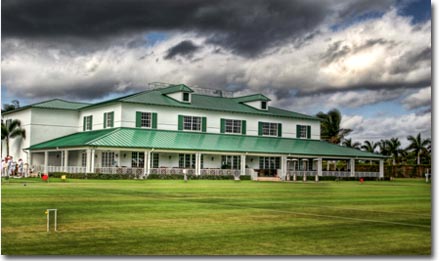
|
| A little photo-shopping of the National Croquet Center's back yard under dark clouds produces a poetic way of saying, "The space is beautiful, the potential is abundant, but where are the people?" Photo by Joe Camosy. |
Which means--doesn't it?--that almost a half million in revenue would still need to be raised from other sources. In this economic climate, that money is not going to come from Outside Events. (The peak year was 2006, with more than $350,000 generated from those events.)
Social memberships could redeem the Center’s finances.
The lost Social members cut off in January of 2005 had fueled the social activity at the club as the Palm Beach dual members never could. The strategy was to recruit A LOT of Social members, encouraging them to populate the bar and the dining room, and not ask them for expensive annual dues—just several hundred dollars to start. Their most important role, in the beginning, was to build the numbers and increase the value of club membership in all categories, and that's what they were doing—until they were cut off abruptly in 2005.
My mid-term strategy was to build membership to the 600 level, at which point memberships would become scarce—recognizing scarcity as the ultimate marketing tool, especially in social club membership. When membership reaches the 600 level, membership fees will then begin to be adjusted upward at all levels, to whatever the market will bear.
I can easily envision implementing a long-term strategy, after a few years, of increasing the price of the Social membership (with limited half-court Golf Croquet play allowed) to $1,000—-as this class of membership grows to at least 300, and maybe more. At those levels, the social atmosphere will have been vitalized along with improved bar and dining service and expanded hours supported by greater numbers. Membership in the National Croquet Center will be more valuable, and thus will cost more. With three hundred resident "full" or "dual" members, the member roster will be completely full, and the National Croquet Center will become an increasingly profitable business as well as a model croquet club and national headquarters facility.
Have you noticed the very sad irony in pursuing a policy of "serious croquet players only" for membership? "Serious" croquet players use the lawns the most. By the standard formula throughout the world, allowing a maximum of 25 players per lawn, the "capacity" of the NCC is 300. If those 300 members pay a hefty annual membership dues of $1500, that produces $450,000 revenue--about half what the Center needs to flourish—which makes the Center still dependent on outside events, even if the Center remains national headquarters and continues to rent court space for the other local clubs and USCA events.
On the other hand, Social memberships require very little lawn space, with playing privileges limited to double-banked half courts just a few hours each week, planned for times that feed traffic to the bar and dining room.
A balanced approach to development with a long-term strategy of building membership should begin NOW (actually, the day before yesterday). When members tell me, "But we want to recruit croquet players," I remind them, first, that many new members want a toe-in-the-water membership to begin, and some of them WILL become serious croquet players. And sometimes I ask, "When should we start recruiting Social players? Do we have to wait until we have 300 Full members first? Why can't we start now?" I'm still waiting to hear a sensible response to that question.
A further irony—and surely the saddest one—is that the longer the Center delays re-establishing a vital social club, the longer the management will have to allow "the public" into the private club environment. This is unfortunate, as one of the main draws of a social club is “exclusivity.”
Once a healthy level of membership numbers and revenues is funding the club and making the social environment attractive, the LONG-TERM strategy can kick in, creating a truly “exclusive” environment that limits access to the club facilities and thus increases its value in the Palm Beach market.
Strategic planning for long-term development
The striking common element of croquet organizations in most places on the globe is the lack of understanding of the very concept of DEVELOPMENT. That is, what is happening now is NOT AT ALL what should be happening three years from now.
When an enterprise is in its infancy, the planning question is, "How shall the enterprise be developed to it full potential, in maturity?" Business people know that what you do today to get to tomorrow is not necessarily what you'll be doing tomorrow. People who organize and run croquet clubs normally have no occasion for this kind of thinking.
However, the two "mega-centres" absolutely REQUIRE strategic thinking in order to succeed. There is a body of expertise existing which is all about creating the conditions for these infant enterprises to become fully mature, to reach their full potential. It has not happened, on either side of the globe, but all the clues suggest that it can happen, and that it will happen soon.
Something akin to a Change of State if required in the transition from an ordinary croquet club--even a big club--to a multi-functional business enterprise that includes croquet. The croquet club has not much at stake in the way of capital investment, and it doesn't matter very much whether it's run efficiently. The Mega-Center, however, MUST be run efficiently, as a multi-functional business enterprise.
It isn't surprising that the good people who run croquet clubs have not developed the habits of thought that would produce and implement a LONGTERM STRATEGIC DEVELOPMENT PLAN, because they have had no occasion in their lives, most of them, to think in those terms. But the blunt truth is...
Running the mega-centre as a croquet club will not work.
Running the mega-centre as a croquet club with additional income from space rentals and catering will not work. On the other hand...
Running the mega-centre as a multi-functional business enterprise that includes space rentals and catering, business meetings and conferences, a restaurant and bar with regular hours, and an active social club begins to meet the challenge of development, when all those elements are organized and managed to work together and be mutually supportive.
Is membership growth a function of integrated management?
Yes, it is. And in my opinion, the National Croquet Center cannot achieve its potential until there is competent, on-site management to integrate and coordinate everything the staff members must presently do on their own, substantially without management. Perhaps the best example of where that potential is being squandered is in the critical area of new member recruitment and retention.
At the National Croquet Center today, potential members interact with as many as a half-dozen different people in different roles surrounding the Saturday free Introduction to Croquet that is the central focus of member recruitment. First, there’s the phone call to inquire and reserve; second, the person welcoming and greeting at the front desk; third, the manager of the Saturday Introduction, fourth, the specific instructor, fifth (if the guest gets that far) the person they talk to about choosing a category of membership that would work best for them; and sixth, the NCC staff member who gives them the form they fill out and accepts their payment. After joining the club, a seventh or eighth person needs to introduce to them to other members and get them started in regular club activities.
It doesn’t have to be that way. Here’s why:
When the Center opened, all or most of the seven interactions above were usually performed by one person: me. Between 10 and 15 people joined every month on average, with a net gain of 100 members a year. I’m not suggesting that the reason for this steady growth was the brilliance of Bob Alman; his program was effective mostly because ONE PERSON was totally responsible for a new member’s relationship to the club, at every stage, from the time they first set foot inside the clubhouse for a free try-out of Golf Croquet.
The real cost of an expanded staff and splitting off administration and clerical functions into many different parts done by many different persons on staff and in the club has been a radical (and understandable and therefore fixable) decline in membership. When you go to buy a car, you’re never required to talk to a half dozen people at different stages to complete the sale—but that’s what happens routinely at the NCC, so it’s not surprising that the level of new member recruitment is only a fraction of what it was a decade ago.
When the National Croquet Center is able to afford an onsite manager, that manager should have primary responsibility for MEMBERSHIP, at all levels, beginning with greeting guests at the front door, continuing through teaching them the basics of Golf Croquet, describing all the categories of membership and helping them decide which is best for them, and finally enrolling that person in the club, taking their check or credit card, and deciding with them exactly when and how they should get started on the lawn. This is not only workable and possible: In my view it is essential, and I know it works, because I organized and managed that process, from 2000 to the middle of 2003.
All the functions of membership recruitment were divided into many different parts done by many different people, in 2004, and that condition persists. Once members are in the club, administrative and clerical tasks necessary to maintain good membership services can of course continue to be done by the front-office support staff. But that staff, as structured, even with the able and enthusiastic support of the club members, is unable to do a sufficient job of long-term membership development. Membership development needs to be a function of integrated management, aided and abetted by willing and enthusiastic club volunteers and paid staff members.
The opportunity for growing a huge club with a broad demographic--not just elderly people--is provided by these two magnificent mega-centres, half a world apart. In both cases, the lawns are there, the bar and the dining are there, and the population is there, in all its diversity.
Isn't it time we used these showcase facilities to invite everyone into our favorite sport, at whatever level works for them? They can be as serious as they like, or as casual. They can spend most of their time on the court practicing and competing, or all of it in the bar and dining room, so long as their dues are paid.
All we have to do is invite them in, and then make sure we deliver what they want and what we promised.
Here's one final piece of critical advice: For your twenty-something or thirty-something after-work networking evenings at the bar, be sure to provide basic Golf Croquet instruction quickly and simply on the adjacent courts, and then get out of the way. Be invisible. Absolutely no oldies are permitted in the bar at any time, either in front of it or behind it! And people over 50 are allowed on court ONLY when requested for instruction.
READERS ARE INVITED TO SELF-POST YOUR OWN OPINIONS AND FACTS IN OUR READERS' FORUM TITLED "MEGA-CENTRE UPDATE." Just follow the menu on the index page!